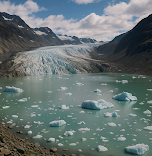Glaciers Melting Faster Than Expected: A Global Wake-Up Call
Recent scientific findings reveal a troubling trend—glaciers around the world are melting much faster than previously anticipated. This alarming development coincides with the first-ever United Nations conference on glaciers, recently held in Tajikistan. The research highlights a stark reality: without immediate climate action, the world may be on track for devastating glacier loss.
The Current Situation: Global Glacier Retreat
A comprehensive study involving 21 scientists from 10 countries examined over 200,000 glaciers worldwide. The findings are concerning. Even if global temperatures were to stabilize today, approximately 39% of glacier ice mass is projected to disappear by the year 2100.
If current climate policies remain unchanged, Earth could warm by 2.7°C, potentially leading to catastrophic losses of glacier ice.
Temperature Rise and Its Impact on Glaciers
- At 2.7°C of warming, only 24% of today’s glacier ice may survive.
- Limiting global warming to 1.5°C could help preserve up to 54% of glacier ice.
- Regions like the European Alps and the Western Rockies could lose up to 90% of glacier mass at 2°C.
Asia’s Melting Glaciers: A Regional Crisis
The Hindu Kush Himalaya region, which supplies water to over two billion people, is facing severe glacier loss. At 2°C of warming, only about 25% of its glaciers may remain. With strong climate action, this figure could improve to 40–45%.
This melting poses a serious threat to food and water security across Asia.
Why Glacier Loss Matters
Melting glaciers have far-reaching consequences:
- Increased frequency of floods and droughts.
- Threats to water availability for millions.
- According to the Asian Development Bank, urgent action is needed to mitigate these risks.
Shifting to clean energy sources and reducing emissions are essential steps to protect glacier regions.
Long-Term Effects: The Slow Fade of Glaciers
Even after temperatures stabilize, glaciers continue to melt—though at a slower pace. Recovery, if possible, could take centuries due to the slow response of glaciers to climate changes.
A Call to Action: Global Cooperation Needed
The recent UN glacier conference brought together over 50 countries. Key actions discussed included:
- Increasing financial support for vulnerable nations.
- Improving climate adaptation strategies.
- Promoting sustainable technologies and policies.
Glaciers: Silent Indicators of Climate Change
Glaciers are more than just natural wonders—they are indicators of climate change. Their visible retreat is a clear warning, but scientists caution that the damage goes far beyond what we can see.
Final Thoughts
The world stands at a crucial moment. Immediate action is needed to protect glaciers and the billions who rely on them. Through global cooperation and sustainable solutions, we can help preserve these vital natural resources for future generations.










